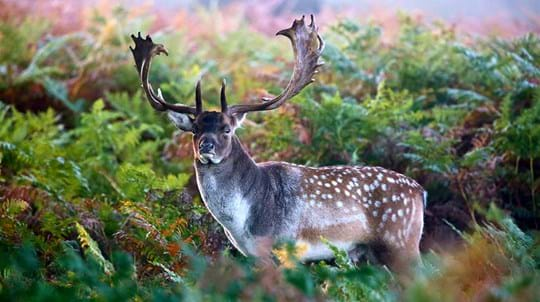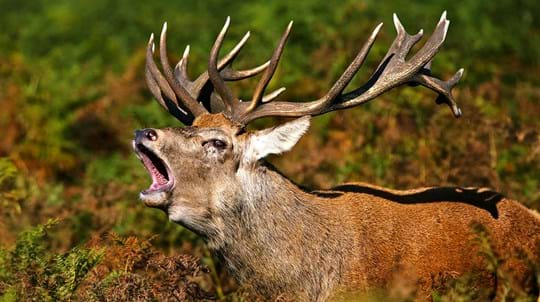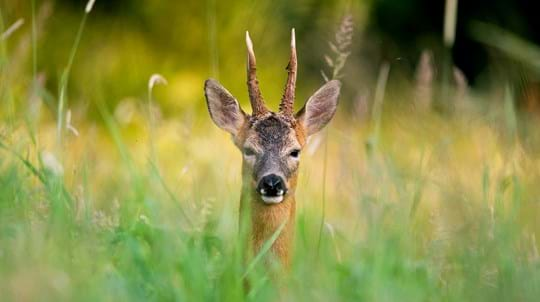
What do deer eat? What are antlers made of? And more deer facts
James Martin • 03 May 2019
From the dainty muntjac to the mighty red stag, the UK is home to six species of wild deer. Learn more about these fascinating creatures.
Read the blogSmall and secretive. Muntjac are an attractive, but potentially damaging, addition to our woodlands, having been introduced in the 20th century.
Common name(s): muntjac deer, Reeves' muntjac
Scientific name: Muntiacus reevesi
Family: Cervidae
Habitat: broadleaved woodland, coniferous woodland
Diet: shrubs, trees, grass, plants and fungi
Predators: fawns taken by foxes. Adults have no predators.
Origin: non-native
The muntjac is a small deer, growing up to 52cm high at the shoulder. They have a light red-brown fur, apart from their stomach which is creamy white. Their black facial markings are diamond-shaped on does (females) and V-shaped on bucks (males). Longer hind legs give the muntjac their characteristic hunched appearance.
Male muntjacs have short, backwards-curving and unbranched antlers. These antlers are shed in late spring and regrow by late autumn. They also have a long pair of canine teeth that protrude from the mouth.

James Martin • 03 May 2019
From the dainty muntjac to the mighty red stag, the UK is home to six species of wild deer. Learn more about these fascinating creatures.
Read the blog
Credit: Amy Lewis / WTML
Muntjac feed on trees and shrubs, shoots, herbs, berries, nuts and fungi. Up to 85 different plants have been recorded in the species’ diet.
Both bucks and does mark their territory with scent from special glands on their faces.
Unlike other species of deer, muntjac do not have a set rutting period and can mate throughout the year. The gestation period is around 210 days, and does usually give birth to a single fawn, although two are sometimes born. Female muntjacs can become pregnant again just days after giving birth. Fawns are weaned after eight weeks, and females reach sexual maturity within their first year.
The muntjac is generally solitary but can sometimes be found in family groups. Bucks defend a territory against other males, but does will overlap with other females more freely.

Credit: Amy Lewis / WTML
Muntjac are widespread across England and parts of Wales, with the greatest numbers in the South East. The species has steadily spread across the country and its population is expected to continue growing. Muntjac are present in both Scotland and Northern Ireland, but in much smaller numbers.
Muntjac deer are also commonly referred to as Reeves’ muntjac and are named after British naturalist and employee of the East India Company – John Russell Reeves (1774–1856). Reeves came across them when he lived in China and sent specimens back to England.
You are more likely to see muntjac at dawn or dusk, when they are most active. Keep an eye out for their tracks on the ground – they leave small hoof prints around 2.5cm in length. They're also known as 'barking deer' as they sometimes make a loud barking noise. So if you're in a wood where muntjac are known to reside, listen out for that sound.

Credit: Anne Marie Kalus / WTML
Muntjac are a non-native species and adults have no natural predators. As a result, densities can reach extremely high levels with a potentially negative impact on the environment. For example, over-grazing can prevent the regeneration of woodland, thereby affecting woodland structure and tree species composition. This has knock-on effects for other species of woodland wildlife. As a result, some populations are culled to control their spread and reduce habitat damage.
Globally, there are at least seven species of muntjac which are distributed across south-east Asia.

Trees woods and wildlife
A social, elegant species with a signature speckled coat and mighty palmate antlers. The non-native fallow deer is now a regular sight in UK woodland. Find out what it eats, how it breeds and how to spot it.

Trees woods and wildlife
The majestic monarch of the glen. Our largest land mammal, red deer, are the royalty of UK woodland. Learn all about them, from what they eat to where they live and how to identify them.

Trees woods and wildlife
Nimble and fleet of foot. The roe is our most widely distributed deer, found in woods across the country. Learn how to distinguish it from other deer, what it eats and where it lives.